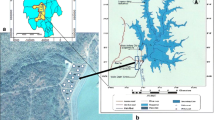Abstract
The effect of salt-induced soil on growth and yield development of paddy rice in Akure, Nigeria was determined. This was to ascertain effect of various salt-inducing parameters on rice yield. Fifteen soil samples were collected and 13 parameters were analysed using standard procedures. The parameters include electrical conductivity (EC), pH, particle size, cation exchange capacity (CEC), exchangeable acidity (EA), organic matter (OM), organic carbon (OC), phosphorus, sodium, calcium (Ca), potassium (K), and magnesium. Geographic information System (GIS) mapping was also carried out on the affected areas and results compared with the international standards. From the results, predominant soil class was clay loam which is excellent for rice growth while salinity levels were not in excess to lead to stress or low rice yield although very low values of N and K were recorded. EC, CEC and EA were well below critical levels in the soil and with the exception of OM, OC, MC and pH which were statistically significant at P < 0.05, other parameters were statistically non-significant. GIS mapping also showed traces of salt but not in high concentration levels as to result in crop stress.






Similar content being viewed by others
References
Akinbile CO (2006) Hawked water quality and health implications in AKURE, Nigeria. Botswana J Technol 15(2):70–75
Akinbile CO, Sangodoyin AY (2011) Evapotranspiration, soil and water quality implications on upland rice production. Asian J Crop Sci 3(4):169–178
Akinbile CO, Sangodoyin AY, Nwilene FE (2007) Growth and yield responses of upland rice (NERICA) under different water regimes in Ibadan, Nigeria. J Appl Irrig Sci 42(2):199–206
Akinbile CO, Abd-El-Latiff KM, Yusoff MS, Abdullah R (2011) Rice production and water use efficiency for self-sufficiency in Malaysia: a review. Trends Appl Sci Res 6(10):1127–1140
Akram M, Hussain S, Akhtar M, Rasul E (2001) Impact of NaCl salinity on yield components of some wheat accessions/varieties. Int J Agric Biol 4:156–158
American Public Health Association (APHA) (2005) American water works association, water pollution control federation. standard methods for the examination of water and waste water, 21st edn. American Public Health Association, Washington DC
Ashraf M (2004) Some important physiological selection criteria for salt tolerance in plants. Flora 199:361–376
Ashraf M (2009) Biotechnological approach of improving plant salt tolerance using antioxidants as markers. Biotechnol Adv 27:84–93
Aslam M, Qureshi RH, Ahmed N (1993) A rapid screening technique for salt tolerance in rice (Oryza sativa L.). Plant Soil 150:99–107
Borsani O, Valpuesta V, Botella MA (2003) Developing salt tolerance plant in a new century: a molecular biology approach. Plant Cell, Tissue Organ Cult 73:101–115
Czyż EA, Dexter AR (2012) Plant wilting can be caused either by the plant or by the soil. Soil Res 50(8):708–713
El-Saidi MT (1997) Salinity and its effect on growth, yield and some physiological processes of crop plants. In: Jaiwal PK, Singh RP, Gulati A (eds) Strategies for improving salt tolerance in higher plants. Science Publ, Enfield, pp 111–127
FAO (2008) Land and plant nutrition management service. Retrieved from: http://www.fao.org/agb/agl/agll/spush. August 2013
Gregorio GB, Senadhira D, Mendoza RD, Manigbas NL, Roxas JP, Guerta CQ (2002) Progress in breeding for salinity tolerance and associated abiotic stresses in rice. Field Crops Res 76:91–101
Ibitoye AA (2001) Effects of municipal refuse dump on soil and water quality in Akure Metropolis. J Appl Soil Sci 2:16–24
Jampeetong A, Brix H (2009) Effects of NaCl salinity on growth, morphology, photosynthesis and proline accumulation of Salvinia natans. Aquat Bot 91:181–186
Longtau S (2003) Rice production in Nigeria. Literature review. Multi-agency partnerships in West African agriculture. A review and description of rice production system in Nigeria, pp 98
Mills AJ, Fey MV, Gröngröft A, Petersen A, Medinski TV (2006) Unravelling the effects of soil properties on water infiltration: segmented quartile regression on a large data set from arid south-west Africa. Soil Res 44(8):783–797
Munns R, Tester M (2008) Mechanisms of salinity tolerance. Annu Rev Plant Biol 59:651–681
Nishimura TS, Cha-um M, Takagaki S, Ohyama K (2011) Survival percentage, photosynthetic abilities and growth characters of two indica rice (Oryza sativa L. spp. indica) cultivars in response to isoosmotic stress. Span J Agric Res 9:262–270
Nwanze K, Savitri M, Patrick K, Samuel B (2006) Rice development in sub-Saharan Africa. J Sci Food Agric 86(5):675–677
Rácz P, Szüle Z (2009) Relationship between the looseness of soil and the electric conductivity. Res Agric Eng 55(4):136–140
Ryšan L, Šařec O (2008) Research of correlation between electric soil conductivity and yield based on the use of GPS technology. Res Agric Eng 54(3):136–147
Sahrawat KL (2005) Fertility and organic matter in submerged rice soil, International Crops Research Institute for the Semi-Arid Tropics, Patancheru 502 324. India Curr Sci 88(5):23–29
Sairam RK, Veerabhadra RKV, Srivastava GC (2002) Differential response of wheat genotypes to long term salinity stress in relation to oxidative stress, antioxidant activity and osmolyte concentration. Plant Sci 163:1037–1046
Shaheen R, Hood-Nowotony RC (2005) Carbon isotope discrimination: potential for screening salinity tolerance in rice at the seedling stage using hydroponics. Plant Breed 124:220–224
Singh RK, Gregorio GB, Jain RK (2007) QTL mapping for salinity tolerance in rice. Physiol Plant Mol Biol 13:87–99
Siringam K, Juntawong N, Cha-um S, Kirdmanee C (2011) Salt stress induced ion accumulation, ion homeostasis, membrane injury and sugar contents in salt-sensitive rice (Oryza sativa L.spp. indica) roots under isosmotic conditions. Afr J Biotechnol 10:1340–1346
Soil Science Society of Nigeria (SSSN) (2012) Glossary of Soil Science Terms. P.78. SSSN, ABU Zaira, Nigeria WA
Zeng L (2000) Salinity effects on seedling growth and yield of rice. Crop Sci 40:996–1003
Acknowledgments
The authors are grateful to The World Academy of Science (TWAS) for providing three months Visiting Scholar fellowship for Dr. Christopher Oluwakunmi AKINBILE (FR Number: 3240275076) and the Universiti Putra Malaysia (UPM) that enabled him utilize the fellowship.
Author information
Authors and Affiliations
Corresponding author
Rights and permissions
About this article
Cite this article
Akinbile, C.O., Adegbola, O.A. & Akande, S.O. Determining the effect of salt-induced soil on paddy rice development and yield using GIS mapping. Paddy Water Environ 14, 313–323 (2016). https://doi.org/10.1007/s10333-015-0501-3
Received:
Revised:
Accepted:
Published:
Issue Date:
DOI: https://doi.org/10.1007/s10333-015-0501-3




